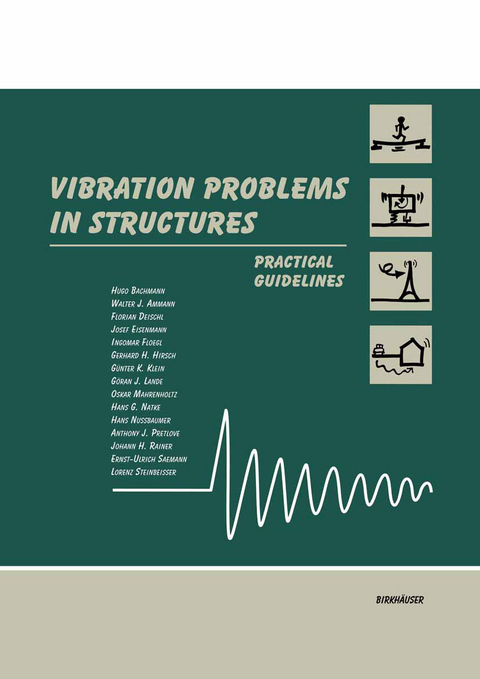
Vibration Problems in Structures
Springer Basel (Verlag)
978-3-0348-9955-0 (ISBN)
1 Vibrations induced by people.- 1.1 Pedestrian bridges.- 1.2 Floors with walking people.- 1.3 Floors for sport or dance activities.- 1.4 Floors with fixed seating and spectator galleries.- 1.5 High-diving platforms.- References to Chapter 1.- 2 Machinery-induced vibrations.- 2.1 Machine foundations and supports.- 2.2 Bell towers.- 2.3 Structure-borne sound.- 2.4 Ground-transmitted vibrations.- References to Chapter 2.- 3 Wind-induced vibrations.- 3.1 Buildings.- 3.2 Towers.- 3.3 Chimneys and Masts.- 3.4 Guyed Masts.- 3.5 Pylons.- 3.6 Suspension and Cable-Stayed Bridges.- 3.7 Cantilevered Roofs.- References to Chapter 3.- 4 Vibrations induced by traffic and construction activity.- 4.1 Roads.- 4.2 Railways.- 4.3 Bridges.- 4.4 Construction Work.- References to Chapter 4.- A Basic vibration theory and its application to beams and plates.- A.1 Free vibration.- A.2 Forced vibration.- A.3 Harmonic excitation.- A.4 Periodic excitation.- A.4.1 Fourier analysis of the forcing function.- A.4.2 How the Fourier decomposition works.- A.4.3 The Fourier Transform.- A.5 Tuning of a structure.- A.6 Impedance.- A.7 Vibration Isolation (Transmissibility).- A.8 Continuous systems and their equivalent SDOF systems.- B Decibel Scales.- B.1 Sound pressure level.- B.2 Weighting of the sound pressure level.- C Damping.- C.1 Introduction.- C.2 Damping Quantities (Definitions, Interpretations).- C.3 Measurement of damping properties of structures.- C.3.1 Decay curve method.- C.3.2 Bandwidth method.- C.3.3 Conclusions.- C.4 Damping mechanisms in reinforced concrete.- C.5 Overall damping of a structure.- C.5.1 Damping of the bare structure.- C.5.2 Damping by non-structural elements.- C.5.3 Damping by energy radiation to the soil.- C.5.4 Overall damping.- D Tuned vibration absorbers.- D.1 Definition.- D.2 Modelling and differential equations of motion.- D.3 Optimum tuning and optimum damping of the absorber.- D.4 Practical hints.- E Wave Propagation.- E.1 Introduction.- E.2 Wave types and propagation velocities.- E.3 Attenuation laws.- F Behaviour of concrete and steel under dynamic actions.- F.1 Introduction.- F.2 Behaviour of concrete.- F.2.1 Modulus of elasticity.- F.2.2 Compressive strength.- F.2.3 Ultimate strain in compression.- F.2.4 Tensile strength.- F.2.5 Ultimate strain in tension.- F.2.6 Bond between reinforcing steel and concrete.- F.3 Behaviour of reinforcing steel.- F.3.1 Modulus of Elasticity.- F.3.2 Strength in Tension.- F.3.3 Strain in tension.- G Dynamic forces from rhythmical human body motions.- G.1 Rhythmical human body motions.- G.2 Representative types of activity.- G.3 Normalised dynamic forces.- H Dynamic effects from wind.- H.1 Basic theory.- H.l.1 Wind speed and pressure.- H.l.2 Statistical characteristics.- a) Gust spectrum.- b) Aerodynamic admittance function.- c) Spectral density of the wind force.- H.1.3 Dynamic effects.- H.2 Vibrations in along-wind direction induced by gusts.- H.2.1 Spectral methods.- a) Mechanical amplification function.- b) Spectral density of the system response.- H.2.2 Static equivalent force method based on stochastic loading.- H.2.3 Static equivalent force method based on deterministic loading.- H.2.4 Remedial measures.- H.3 Vibrations in along-wind direction induced by buffeting.- H.4 Vibrations in across-wind direction induced by vortex-shedding.- H.4.1 Single structures.- H.4.2 Several structures one behind another.- H.4.3 Conical structures.- H.4.4 Vibrations of shells.- H.5 Vibrations in across-wind direction: Galloping.- H.6 Vibrations in across-wind direction: flutter.- H.7 Damping of high and slenderRC structures subjected to wind.- I Human response to vibrations.- I.1 Introduction.- I.2 Codes of practice.- I.2.1 ISO 2631.- I.2.2 DIN 4150/2.- J Building response to vibrations.- J.1 General.- J.2 Examples of recommended limit values.- References to the Appendices.- List of Codes and Standards.
| Erscheint lt. Verlag | 12.10.2011 |
|---|---|
| Zusatzinfo | XVII, 237 p. |
| Verlagsort | Basel |
| Sprache | englisch |
| Maße | 170 x 240 mm |
| Gewicht | 447 g |
| Themenwelt | Technik ► Bauwesen |
| Technik ► Maschinenbau | |
| Schlagworte | Concrete • DIN • Environment • Fundament • Mann • Natur • Norm • Production • Pylon • quality • reinforced concrete • Service • Structure • Tower • Vibration |
| ISBN-10 | 3-0348-9955-6 / 3034899556 |
| ISBN-13 | 978-3-0348-9955-0 / 9783034899550 |
| Zustand | Neuware |
| Haben Sie eine Frage zum Produkt? |
aus dem Bereich


